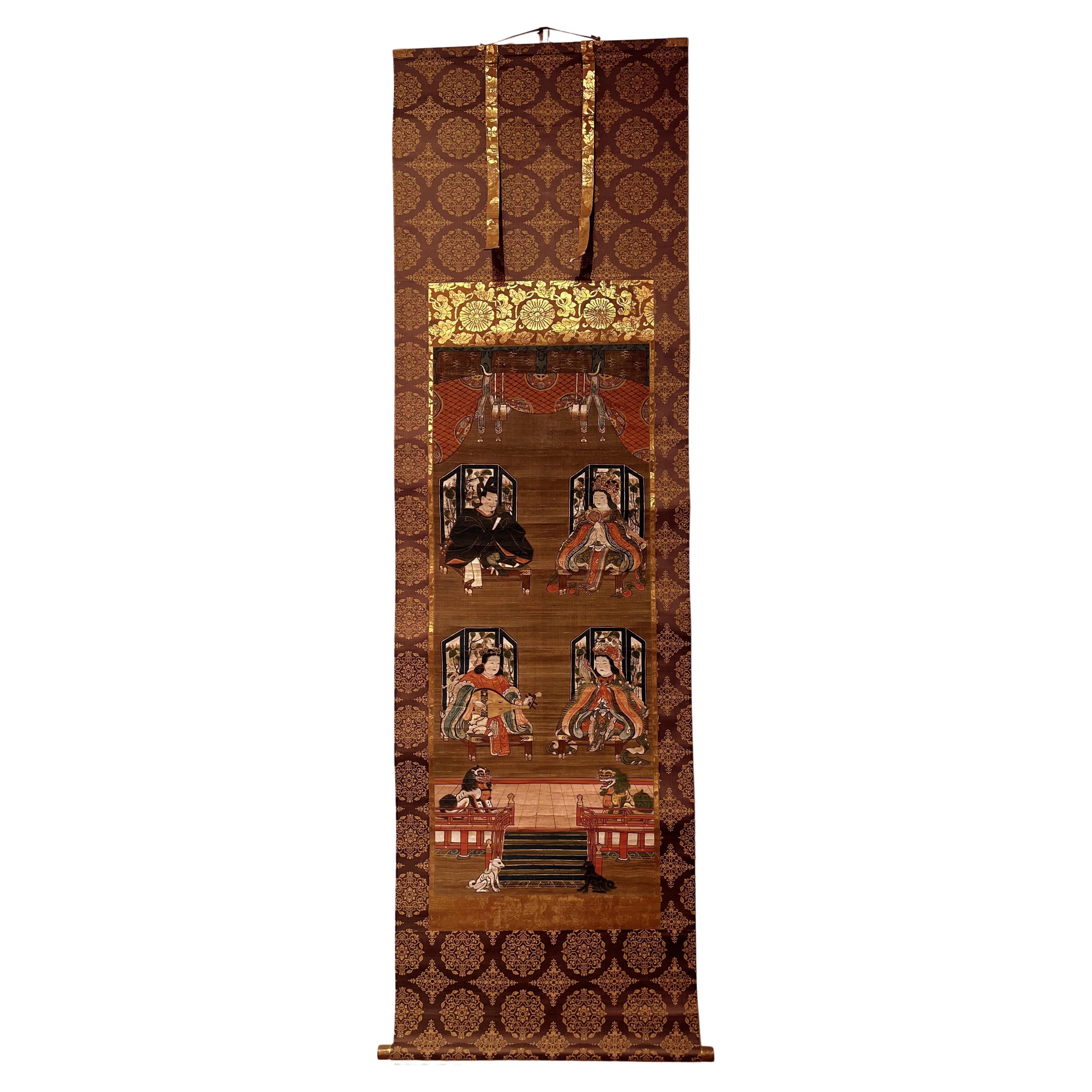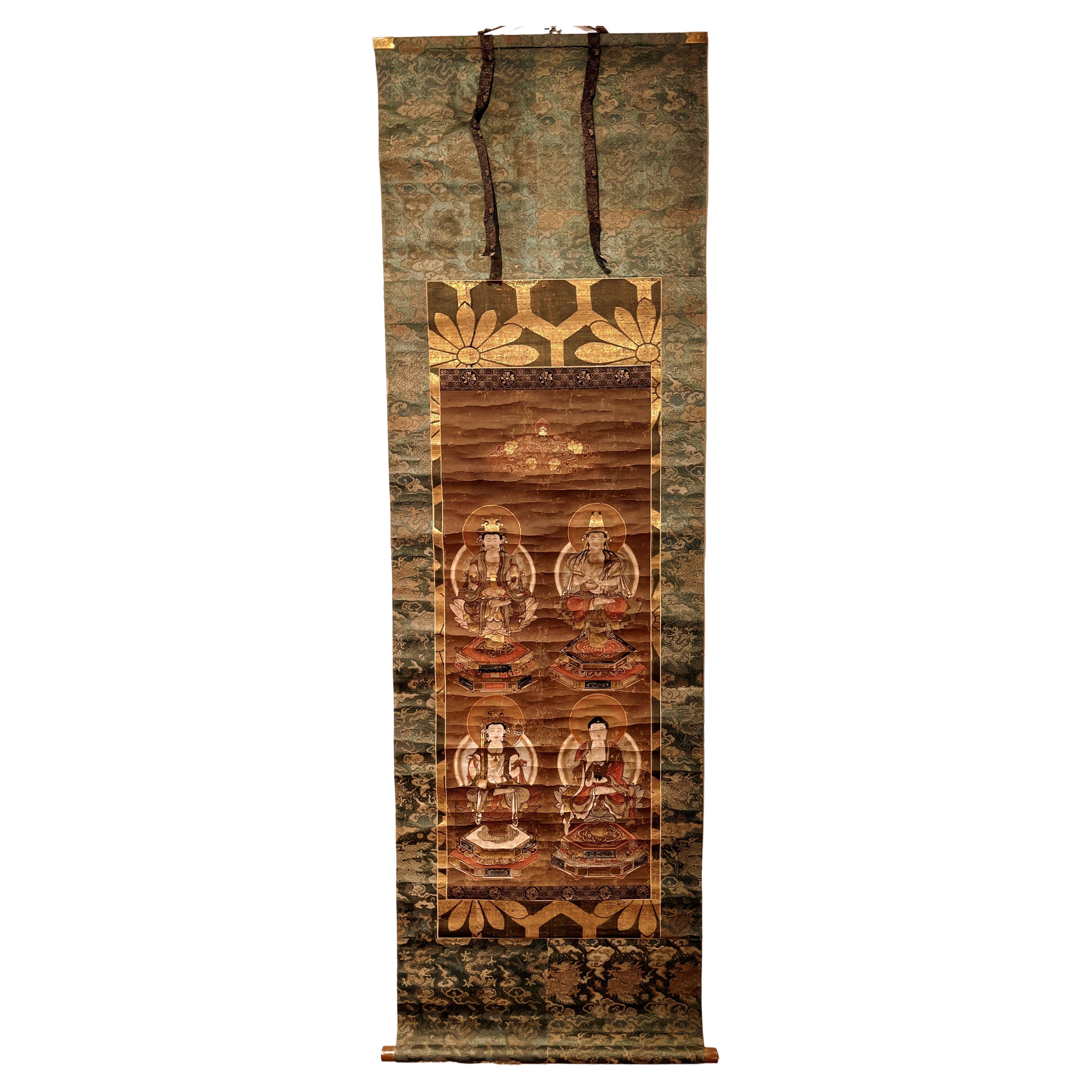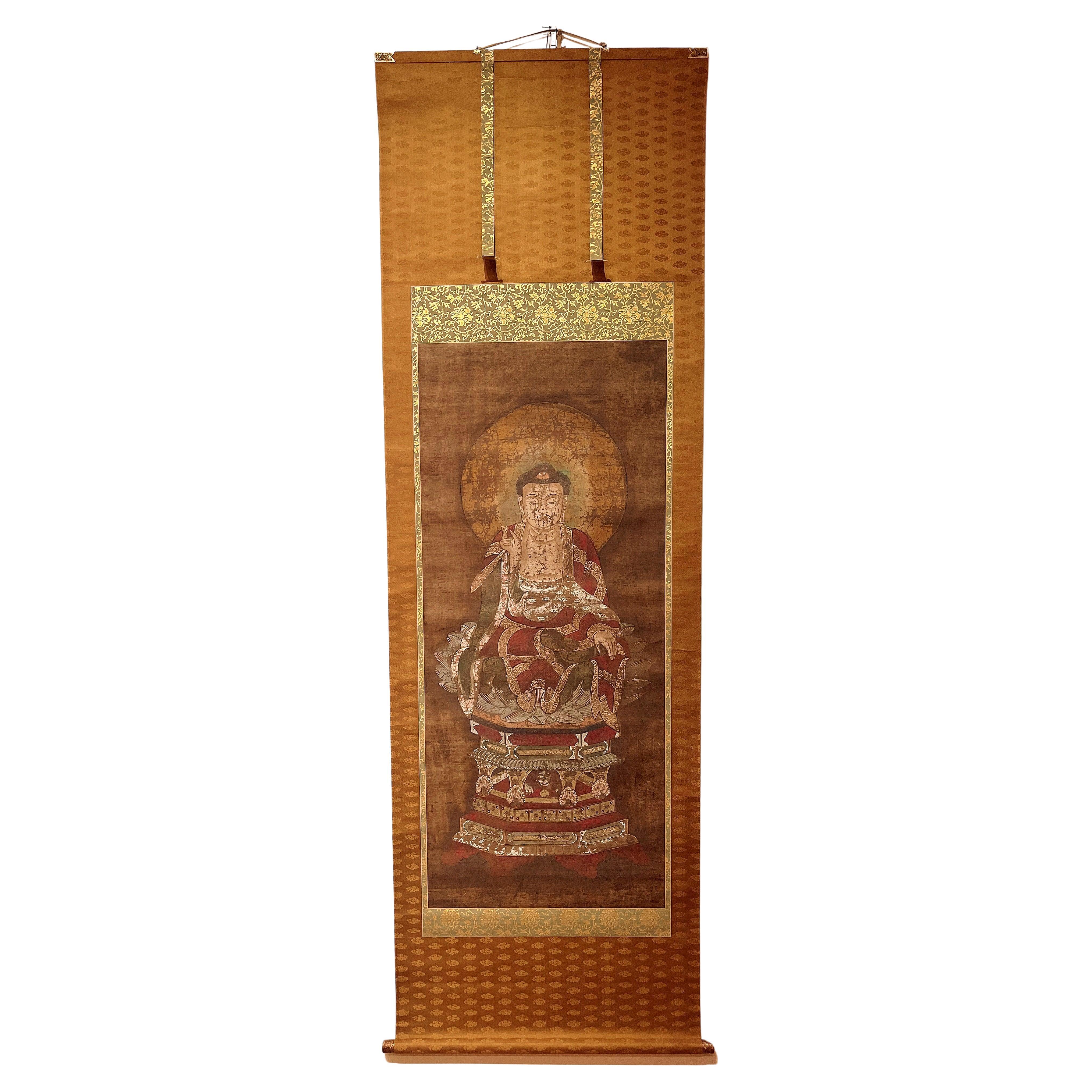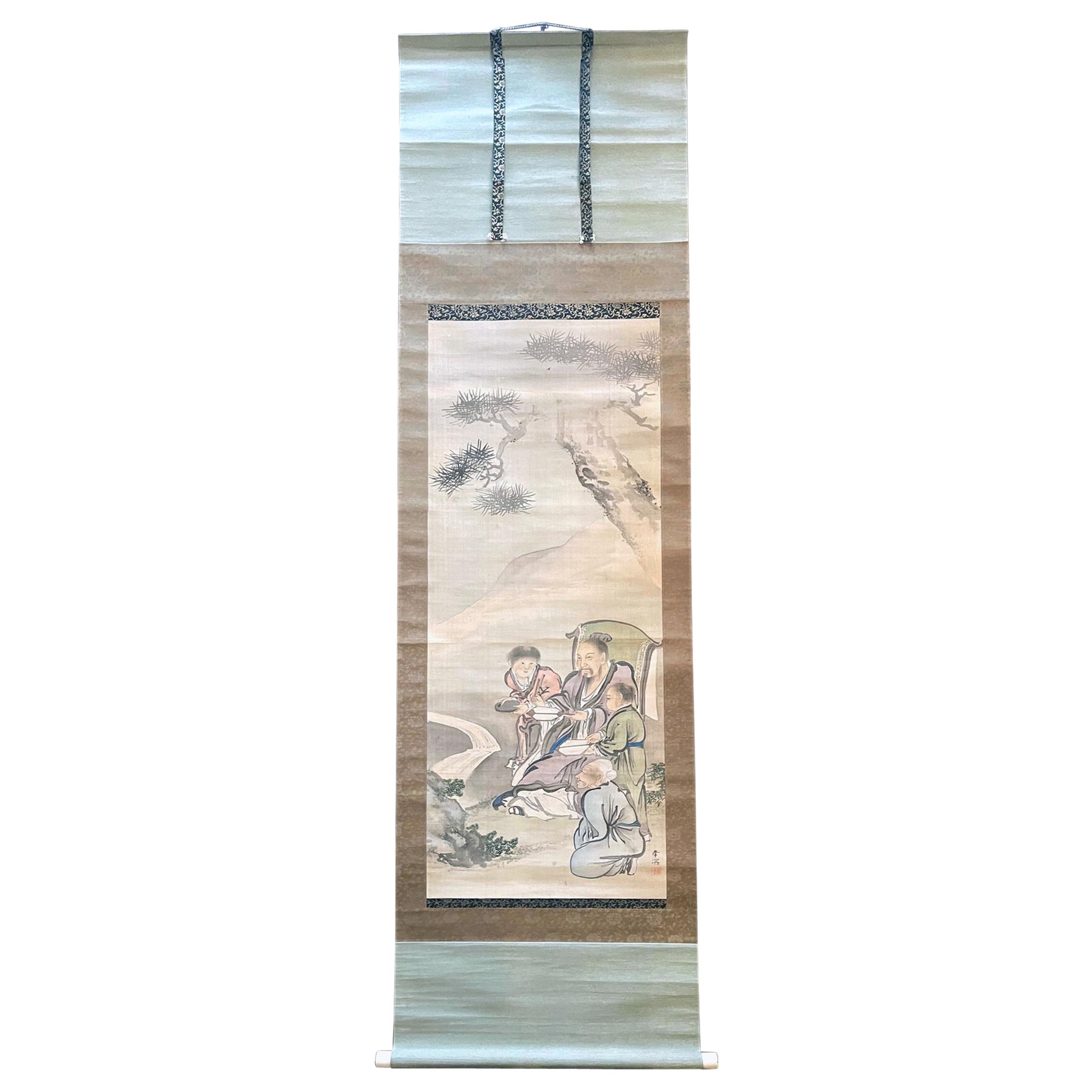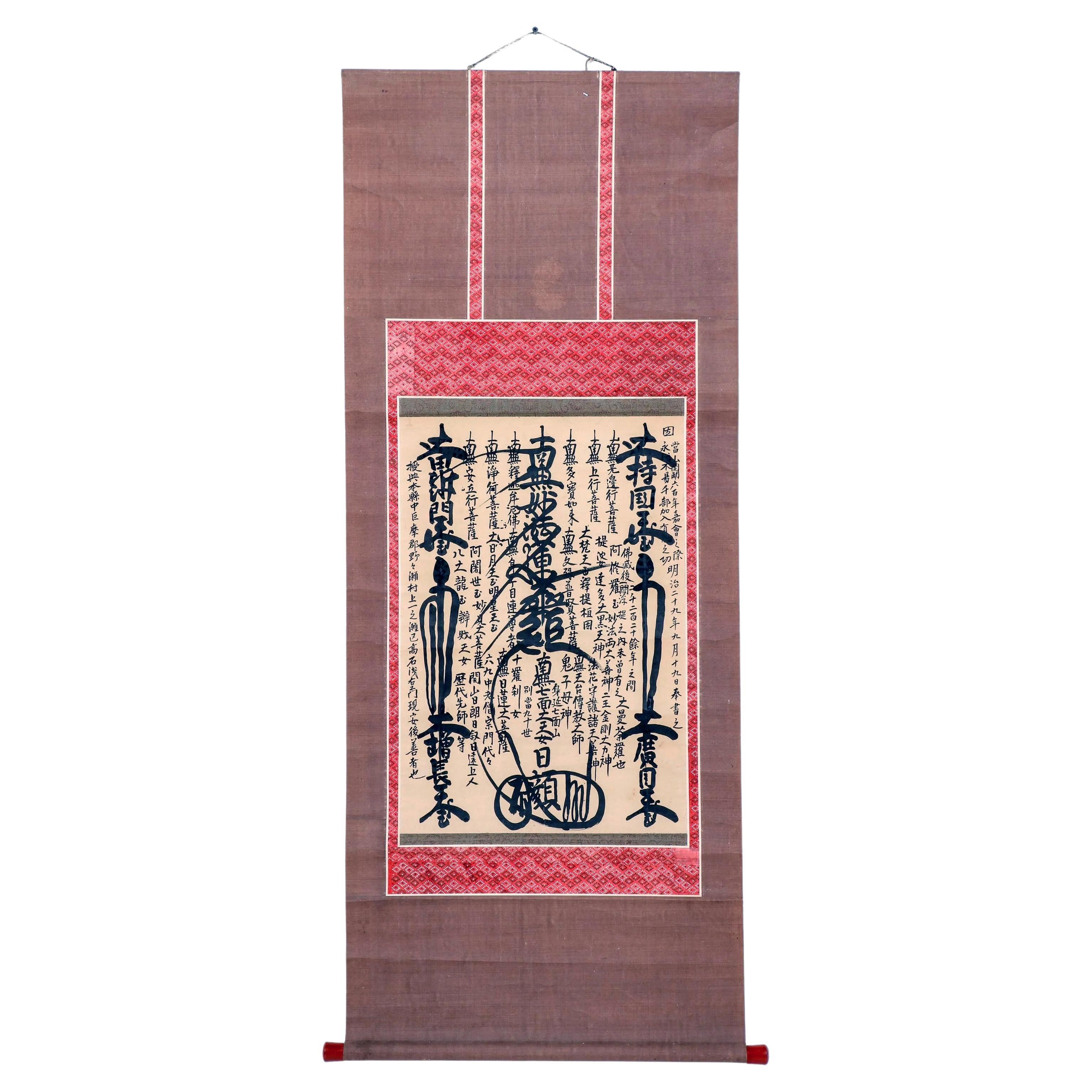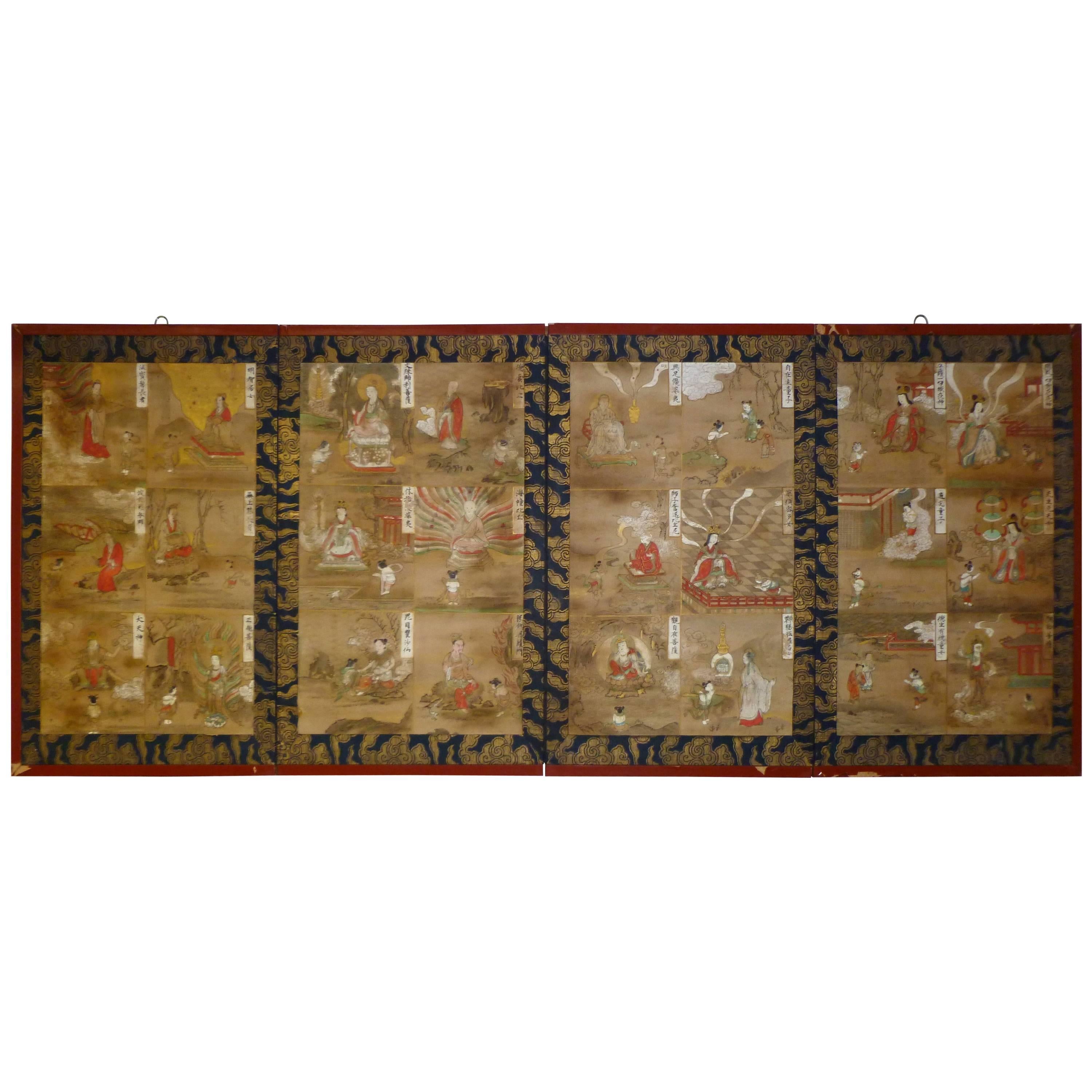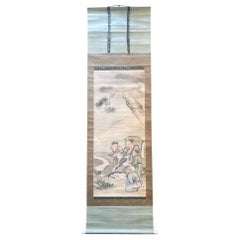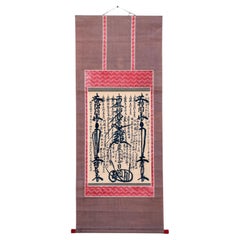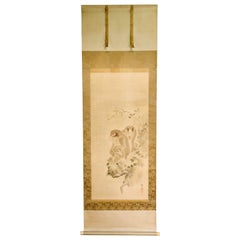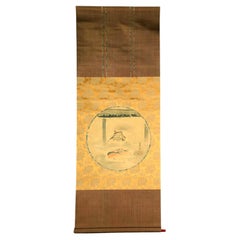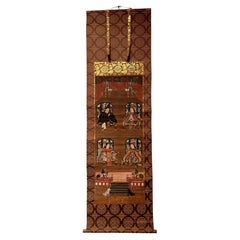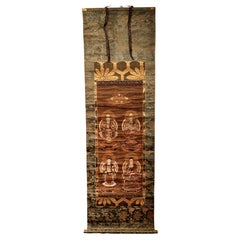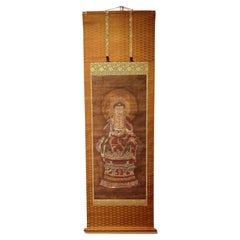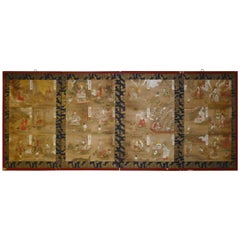Items Similar to Japanese Silk Suijaku Scroll Nyorai-Kojin with Mixed Buddhism and Shinto Deities
Want more images or videos?
Request additional images or videos from the seller
1 of 13
Japanese Silk Suijaku Scroll Nyorai-Kojin with Mixed Buddhism and Shinto Deities
$15,000
£11,338.14
€13,029.54
CA$20,887.41
A$23,236.39
CHF 12,180.80
MX$283,942.95
NOK 155,107.35
SEK 146,012.11
DKK 97,260.57
Shipping
Retrieving quote...The 1stDibs Promise:
Authenticity Guarantee,
Money-Back Guarantee,
24-Hour Cancellation
About the Item
A Japanese silk Suijaku hanging scroll beautifully presented in a custom wood shadow box frame from Edo period (circa 18-19th century). The scroll, surmounted on golden brocade was painted in fine details with gouache, ink and gold powder highlight, served as a Suijaku mandala for the worshippers. Honji Suijaku is a complicated religious concept uniquely developed in Japan. It mixed and hybrid the Buddism deities with native shinto spirits (known as Kami), which were seen as local manifestations (the suijaku, literally means a "trace") of Buddhist deities (the honji literally the original ground). The original idea may lie with the synergetic strategy to spread Buddism by making it more relatable to the local population who had already worshiped Shinto gods. The paradigm, adopted in the 10th century from an orignal Chinese concept, remained a defining feature of Japanese religious life up to the end of the Edo period (1868). Instead of being confined to deities, its application was often extended to historical figures as shown on this scroll.
This long hanging scroll depicts an arrangement of 21 figures including Buddhism and Shinto deities as well as two historical figures on the bottom. Each figure was name-tagged in Kanji for easy identification by the worshippers. It was used in the temple or shrine so that when the worshipper prayed in front the mandala, they prayed simultaneously to all the deities.
On the very top, sits Nyorai-Kojin, a hybrid deity of Nyorai Buddha and Kojin, the kaki for fire, stove and kitchen. From the top to bottom and left to right, here is the list of the deities: Kanon with Thousand Hands, Kanon with Willow Branch, Monju Bosatsu, Jizo, Shengjun Jizo, Benzaiten, Marishiten(Marici), Hongu Gongen (literally means the Buddhist divinity's manifestation in the form of a provisional Shinto deity), New Palace Gongen, Taiko Gongen, Inari (Gods of grains and harvest), Daikokuten (Mahakala, god of wealth and fortune), Zouwang Gongen, Ucchusma, Hachiman God (God of War), Kumano Gongen. Master Cihui (912-985 historical figure), Tenjin (Patron kami of intellectual scholarship) and lastly Master Kobo (Kukai, 774-835, historical figure and founder of Shingon School).
Cursive writing in ink on old paper affixed verso (undeciphered). Image measures approx. 44" x 20", scroll approx. 76" x 28", with frame 85.5" x 33.5".
- Dimensions:Height: 85.5 in (217.17 cm)Width: 33.5 in (85.09 cm)Depth: 3 in (7.62 cm)
- Style:Edo (Of the Period)
- Materials and Techniques:
- Place of Origin:
- Period:
- Date of Manufacture:18-19th century
- Condition:Wear consistent with age and use. Antique scroll framed, appears in fine condition with minor wear and scattered toning as expected. Not examined out of the frame.
- Seller Location:Atlanta, GA
- Reference Number:1stDibs: LU945033505782
About the Seller
4.9
Platinum Seller
Premium sellers with a 4.7+ rating and 24-hour response times
Established in 2006
1stDibs seller since 2010
564 sales on 1stDibs
Typical response time: <1 hour
- ShippingRetrieving quote...Shipping from: Atlanta, GA
- Return Policy
Authenticity Guarantee
In the unlikely event there’s an issue with an item’s authenticity, contact us within 1 year for a full refund. DetailsMoney-Back Guarantee
If your item is not as described, is damaged in transit, or does not arrive, contact us within 7 days for a full refund. Details24-Hour Cancellation
You have a 24-hour grace period in which to reconsider your purchase, with no questions asked.Vetted Professional Sellers
Our world-class sellers must adhere to strict standards for service and quality, maintaining the integrity of our listings.Price-Match Guarantee
If you find that a seller listed the same item for a lower price elsewhere, we’ll match it.Trusted Global Delivery
Our best-in-class carrier network provides specialized shipping options worldwide, including custom delivery.More From This Seller
View AllJapanese Silk Scroll by Haruki Nanmei Edo Period
Located in Atlanta, GA
A Japanese hanging silk scroll by late Edo period painter Haruki Nanmei (1795-1878). The gouache painting was in the tradition of Kano school and depicts an old scholar dressed in lo...
Category
Antique 19th Century Japanese Edo Paintings and Screens
Materials
Silk, Paper
Japanese Gohonzon Buddhist Calligraphy Mandala Scroll Meiji Period
Located in Atlanta, GA
A Japanese sumi ink calligraphy Buddhist mandala mounted as a paper hanging scroll known as Kakejiku or sometimes Moji mandala. Termed as gohonzon in Japanese, it is a venerated object within Nichiren Buddhism (Hokkeshu; lotus sect). The originally concept was developed by the 13th century Buddhist priest Nichiren to guide the energy of the devotional chanting to...
Category
Antique 1890s Japanese Meiji Paintings and Screens
Materials
Paper
Japanese Silk Scroll Painting of Moneys Edo Period Mori Tetsuzan
Located in Atlanta, GA
A Japanese mounted vertical hanging scroll painting by Mori Tetsuzan (Japanese, 1775-1841) circa 19th century Edo period. The watercolor and ink on silk ...
Category
Antique 19th Century Japanese Japonisme Paintings and Screens
Materials
Silk, Paper
Japanese Silk Scroll of Daruma Hanabusa Itcho Edo Period
Located in Atlanta, GA
A Japanese hanging scroll attributed to Edo period painter Hanabusa Itcho (1652-1724). The artwork features a silk roundel nicely mounted in golden brocade background. The painting depicts a robed Daruma seated in meditation with his eyes widely open. The rendition of the famous monk, one of the most beloved subjects in Japanese art, was extremely minimalistic. With just a few effective ink strokes and patches of watercolor, it managed to successfully highlight the essence and spirit of Daruma. The roundel was possibly a center fragment of a larger painting by the artist and was remounted historically. Signed with one of his artist's names. It comes with a wood scroll box with ink inscription of title and artist formal name.
For a painting with the same signature, see number 1881,1210,0.1719 in the collection of the British Musuem. Also a horizontal scroll...
Category
Antique 18th Century Japanese Edo Paintings and Screens
Materials
Silk, Paper
Antique Japanese Hanging Scroll Attributed to Iwasa Matabei
Located in Atlanta, GA
An antique ink and color on paper hanging scroll (kakejiku) with brocade border. It appears to be a fragment of a larger hand scroll depicting a procession of a lord with his entoura...
Category
Antique Early 17th Century Japanese Japonisme Paintings and Screens
Materials
Silk, Paper
Japanese Gohonzon Buddhist Calligraphy Mandala Scroll Meiji Period
Located in Atlanta, GA
A Japanese sumi ink calligraphy Buddhist mandala mounted as a paper hanging scroll known as Kakejiku or sometimes Moji mandala. Termed as gohonzon in Japanese, it is a venerated object within Nichiren Buddhism (Hokkeshu; lotus sect). The originally concept was developed by the 13th century Buddhist priest Nichiren to guide the energy of the devotional chanting to...
Category
Antique Early 1900s Japanese Meiji Paintings and Screens
Materials
Paper
You May Also Like
Japanese Shito Religion of Four Deities, Scroll Painting
Located in Greenwich, CT
Japanese painting of Shito religion shrine depicted the four deities in court dress represent a hierarchy of local Shinto gods (kami) and with pair of guardian lions and lower stairw...
Category
Antique 19th Century Japanese Paintings and Screens
Materials
Silk
$5,500 Sale Price
26% Off
Japanese Buddhist Painting, Hanging Scroll Painting
Located in Greenwich, CT
Japanese Buddhist Painting , Hanging Scroll Painting
Depicted Amituofo and Budhisattva in the painting sitting on the lotus crown seats. Bea...
Category
Antique 19th Century Japanese Paintings and Screens
Materials
Paper
$3,800 Sale Price
34% Off
Japanese Buddhist Painting of Sitting on Lotus Crown, Scroll Painting
Located in Greenwich, CT
Japanese Buddhist Painting Sitting on Lotus Crown Seat
Ink and color on silk
Overall size : 25.6" width 81" height
Image size: 19.7" widt...
Category
Antique 19th Century Japanese Paintings and Screens
Materials
Silk
Japanese Buddhist Teaching Painting
Located in Greenwich, CT
Japanese Buddhist teaching painting, set of four paintings with 24 Buddhist stories with Japanese written characters in each story on one screen. Provenance: Purchased from Christie's South Kensington...
Category
Antique 1820s Japanese Edo Paintings and Screens
Materials
Paper
2nd Half of the 18th Century Scroll Painting on Silk by Maruyama Okyo
Located in Chapel Hill, NC
2nd Half of the 18th century Scroll Painting on Silk by Maruyama Okyo now Framed, Japanese. Pine in Snow. Signed along lower left & with artist's seal in red. Acquired in 1967 in Nik...
Category
Antique Late 18th Century Japanese Anglo-Japanese Paintings
Materials
Silk, Paint
Lovely Japanese 18th-19th Century Edo or Meiji Scroll Painting Seven Lucky God
Located in Amsterdam, Noord Holland
Interesting and finely painted Japanese painting.
Provenance: From an old family from Kyoto.
width of about 62.0 cm axial destination width of about 67.8 cm × length of about 1...
Category
20th Century Japanese Meiji Paintings and Screens
Materials
Bronze
$1,341 Sale Price
20% Off
More Ways To Browse
Hanging Scrolls
Ink Scroll
Japanese Paper Scroll
Japanese Silk Brocade
Chinese Scroll Paintings
Asian Deity
Scroll Painting Silk
Praying Hands
Antique Hand Painted Japanese China
Silk Japanese Scrolls
Japanese Painting Silk Gold
Japanese Wood Temple
19th Century Fire Screen
19th Century Chinese School
Japanese Wood Figure
Japanese Silk Painting Ink
Chinese Deity
Japanese Scroll Box
